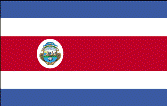|
Costa Rica
|

|
Capital: San Jose
Population: 5,047,561
Brief History of Costa Rica:
Christopher Columbus was the first European to set foot in Costa Rica. It was in 1502 during his last trip to the Americas. The first attempts to settle Costa Rica were difficult. Obstacles such as pirates, weather, disease from mosquitoes, and unfriendly natives prevented permanent settlements for some years. In 1563 the city of Cartago became the first permanent settlement in Costa Rica.
Costa Rica remained a Spanish colony for almost 300 years. In 1821 Costa Rica, together with many other Central American colonies, declared independence from Spain. In 1838 it became an independent country.
Since the late 19th century, only two brief periods of violence have marred the country's democratic development. In 1849, Costa Rica dissolved its armed forces. Although it still maintains a large agricultural sector, Costa Rica has expanded its economy to include strong technology and tourism industries. The standard of living is relatively high. Land ownership is widespread.
Costa Rica has been a democratic country since 1899. There were only two major disruptions to this. The first was from 1917 to 1919 when Federico Tinoco was dictator and in 1948 when Jose Figueres and some rebels revolted. Figueres became the new president and under him a new constitution was written that included the right for all to vote and got rid of the country?s military.
The name Costa Rica comes from the Spanish for Rich Coast. The Spanish thought the land would have gold and other rich minerals, however, this wasn't the case and instead they used the island for crops.
The Geography of Costa Rica
Total Size: 51,100 square km
Size Comparison: slightly smaller than West Virginia
Geographical Coordinates: 10 00 N, 84 00 W
World Region or Continent: Central America
General Terrain: coastal plains separated by rugged mountains including over 100 volcanic cones, of which several are major volcanoes
Geographical Low Point: Pacific Ocean 0 m
Geographical High Point: Cerro Chirripo 3,810 m
Climate: tropical and subtropical; dry season (December to April); rainy season (May to November); cooler in highlands
Major cities: SAN JOSE (capital) 1.416 million (2009), Limon
The People of Costa Rica
Type of Government: democratic republic
Languages Spoken: Spanish (official), English
Independence: 15 September 1821 (from Spain)
National Holiday: Independence Day, 15 September (1821)
Nationality: Costa Rican(s)
Religions: Roman Catholic 76.3%, Evangelical 13.7%, Jehovah's Witnesses 1.3%, other Protestant 0.7%, other 4.8%, none 3.2%
National Symbol: clay-colored robin known as Yiguirro
National Anthem or Song: Himno Nacional de Costa Rica (National Anthem of Costa Rica)
Economy of Costa Rica
Major Industries: microprocessors, food processing, textiles and clothing, construction materials, fertilizer, plastic products
Agricultural Products: coffee, pineapples, bananas, sugar, corn, rice, beans, potatoes; beef; timber
Natural Resources: hydropower
Major Exports: coffee, bananas, sugar, pineapples; textiles, electronic components, medical equipment
Major Imports: raw materials, consumer goods, capital equipment, petroleum
Currency: Costa Rican colon (CRC)
National GDP: $55,020,000,000
** Source for population (2012 est.) and GDP (2011 est.) is CIA World Factbook.
Back to Geography Home Page
